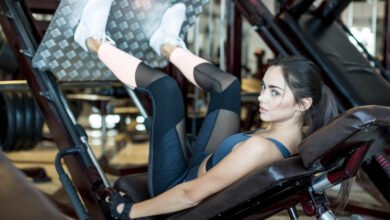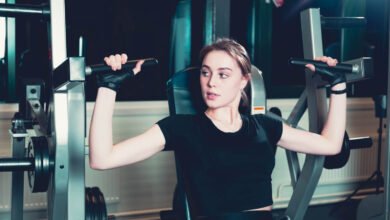How to Use Gym Equipment Safely: A Beginner’s Guide

Welcome to our beginner’s guide on how to use gym equipment safely! Whether you’re a complete newbie to the gym or someone looking to brush up on your safety knowledge, this article is here to help you navigate the world of fitness equipment with confidence.
Using gym equipment can be an excellent way to enhance your workouts and reach your fitness goals, but it’s crucial to prioritize safety to prevent injuries and ensure a positive gym experience.
In this guide, we’ll cover everything you need to know about using gym equipment safely. We’ll provide you with practical tips, essential guidelines, and expert advice to ensure that you have a solid foundation for a safe workout routine.
We’ll break down different types of equipment, offer general safety recommendations, and dive into specific guidelines for using treadmills, weightlifting machines, resistance bands, and more.
We understand that starting out at the gym can feel overwhelming, especially when faced with various machines and equipment. That’s why we’re here to simplify things for you.
You won’t find any complicated jargon or technical terms in this guide. Instead, we’ll explain everything in clear, concise, and easy-to-understand language, ensuring that you can follow along without any confusion.
It’s important to note that this guide is written in our own words, based on our expertise and experience in the field. We have carefully researched and compiled the most essential information to create an informative and engaging resource.
Our goal is to provide you with a human writing style that feels like a friendly conversation, making your learning experience enjoyable and approachable.
So, whether you’re eager to hop on that treadmill, conquer the weightlifting area, or explore other gym equipment, you’re in the right place.
We’re here to equip you with the knowledge and confidence you need to make the most of your gym sessions while keeping safety at the forefront. Let’s dive in and learn how to use gym equipment safely!
Understanding Gym Equipment
When you step into a gym, you’ll likely encounter a wide variety of equipment that can be both exciting and confusing.
We’ll help you understand the different types of gym equipment you’re likely to come across. Don’t worry; we’ll keep things simple and straightforward!
Types of Gym Equipment
- Cardiovascular Equipment: This type of equipment focuses on improving cardiovascular health and endurance. Examples include treadmills, stationary bikes, elliptical trainers, and rowing machines. They get your heart rate up and help burn calories.
- Strength Training Equipment: Strength training equipment is designed to build muscle strength and tone your body. It includes weightlifting machines, free weights (such as dumbbells and barbells), resistance bands, and suspension trainers. These tools are essential for targeting specific muscle groups and increasing overall strength.
- Functional Training Equipment: Functional training equipment emphasizes full-body movements and improves your ability to perform daily activities. Examples include exercise balls, balance boards, and agility ladders. They enhance stability, balance, and coordination.
Common Gym Equipment Terminology
Before we dive deeper into each type of equipment, let’s familiarize ourselves with some common terminology you’ll often come across:
- Reps (Repetitions): Refers to the number of times you perform a specific exercise.
- Sets: A set is a group of repetitions. For example, if you perform 10 reps of bicep curls and then take a break, you’ve completed one set.
- Resistance: This refers to the amount of weight or force you’re working against during an exercise. It can come from machines, free weights, or resistance bands.
- Range of Motion (ROM): The complete movement of a joint or muscle during an exercise, from the starting position to the end position.
- Spotter: A spotter is a person who assists you during certain exercises, providing support and ensuring safety, especially when lifting heavy weights.
Understanding these terms will make it easier to follow exercise instructions and communicate with others at the gym.
Remember, the key here is to focus on understanding the basics of gym equipment without overwhelming yourself with technical details. We want to empower you to feel confident when navigating the gym floor.
Preparing for a Safe Workout

Before you start using gym equipment, it’s essential to take some steps to prepare yourself for a safe and effective workout.
Setting Realistic Fitness Goals:
- Clarify your goals. What do you want to achieve through your workouts? Do you want to lose weight, build muscle, improve endurance, or enhance overall fitness?
- Set achievable milestones. Progress takes time, so it’s important to set realistic goals that you can reach. Celebrate small victories along the way to stay motivated.
Consulting with a Fitness Professional:
- Get guidance from a professional. If you’re new to the gym or unsure about proper form and technique, consider consulting with a fitness professional. They can help you create a personalized workout plan based on your goals and fitness level.
Warm-up and Stretching Exercises:
- Never skip the warm-up. Warming up prepares your body for the workout ahead by increasing blood flow to your muscles and raising your body temperature. It also reduces the risk of strains and pulls.
- Start with light cardio. Get your heart rate up with a few minutes of light cardio, such as brisk walking or cycling.
- Follow up with dynamic stretches. Dynamic stretches engage multiple muscle groups and help increase flexibility and range of motion. Try leg swings, arm circles, and trunk rotations.
- Cool down after your workout. Finish your workout with static stretches to help your body recover and prevent muscle tightness.
By setting realistic goals, seeking professional guidance when needed, and incorporating warm-up and stretching exercises into your routine, you’ll be well-prepared for a safe and successful workout.
General Safety Tips for Using Gym Equipment
When it comes to using gym equipment, safety should always be your top priority. In this section, we’ll share some general safety tips that apply to using all types of gym equipment.
Understanding Proper Form and Technique
Proper form and technique are essential to maximize the benefits of your workouts and prevent injuries.
When using gym equipment, make sure you understand the correct form for each exercise. Poor form can lead to strains, sprains, or even more severe injuries.
Start by learning the basics of each exercise and practice them without weights or resistance.
Focus on your posture, alignment, and range of motion. If needed, seek guidance from a fitness professional to ensure you’re performing the exercises correctly.
Using the Equipment According to Instructions
Each piece of gym equipment comes with instructions on how to use it safely and effectively.
Take the time to read and understand these instructions before using any equipment. Pay attention to weight limits, recommended settings, and any specific precautions.
If you’re unsure about how to operate a particular machine or use a specific piece of equipment, don’t hesitate to ask a gym staff member or a fitness professional for assistance. They will be more than happy to help you.
Maintaining Proper Hygiene and Sanitation
Maintaining good hygiene is crucial in any gym environment. Always bring a clean towel to wipe down equipment before and after use.
This helps prevent the spread of germs and keeps the gym a clean and pleasant place for everyone.
Additionally, remember to bring a water bottle and stay hydrated throughout your workout. Proper hydration not only supports your overall well-being but also helps prevent muscle cramps and fatigue.
Specific Equipment Safety Guidelines

Different types of gym equipment require specific safety guidelines to ensure proper usage and minimize the risk of injuries.
We’ll explore safety tips for using some common types of equipment, including treadmills, weightlifting machines, resistance bands, and more.
Treadmills and Stationary Bikes
- Start with a slow pace and gradually increase the speed or resistance as your body warms up.
- Use the safety clip or key when using a treadmill. Attach it to your clothing so that if you slip or fall, the machine automatically stops.
- Maintain a proper posture while using both treadmills and stationary bikes. Stand tall or sit upright, keeping your back straight.
Weightlifting Machines and Free Weights
- Start with lighter weights and gradually increase the resistance as your strength improves.
- Always use a spotter when lifting heavy weights, especially for exercises like bench press or squats.
- Focus on proper breathing techniques to avoid unnecessary strain. Exhale during the exertion phase and inhale during the relaxation phase.
Resistance Bands and Suspension Trainers
- Inspect the bands or suspension trainers for any signs of wear and tear before each use. Replace them if they’re damaged.
- Securely anchor the bands or suspension trainers to a sturdy structure before performing exercises.
- Maintain control and avoid sudden releases of tension, which can cause the bands or suspension trainers to snap back.
Exercise Balls and Balance Boards
- Inflate the exercise ball to the recommended level. Over-inflating or under-inflating can compromise stability and safety.
- Use a stability base or exercise mat with the ball or balance board to prevent slipping.
- Start with basic exercises and gradually progress to more challenging ones as you improve your balance and stability.
Remember, these guidelines are not exhaustive, but they provide a good starting point for safely using specific gym equipment.
Always follow the instructions provided by the equipment manufacturer and consult with a fitness professional if you’re unsure about proper usage.
Additional Safety Measures
In addition to following equipment-specific safety guidelines, there are some general safety measures you can incorporate into your gym routine. These measures will further enhance your safety and make your workouts more enjoyable.
Using Spotter or Trainer Assistance
When performing exercises that involve heavy weights or have the potential for accidents, it’s beneficial to have a spotter or trainer assist you.
They can provide guidance, ensure proper form, and offer support if you need help during challenging sets.
If you’re unsure about using a particular piece of equipment or attempting a new exercise, don’t hesitate to seek assistance. Having someone watch over you can boost your confidence and prevent potential injuries.
Listening to Your Body and Avoiding Overexertion
It’s important to listen to your body during workouts. Pay attention to any signs of discomfort, pain, or excessive fatigue. Pushing yourself is important, but it’s equally crucial to know your limits and avoid overexertion.
Take breaks as needed and give yourself time to recover between sets or exercises. Rest is an essential component of a safe and effective workout routine.
Staying Hydrated and Taking Breaks
Proper hydration is essential for maintaining optimal performance and preventing dehydration. Drink water before, during, and after your workout to replenish fluids lost through sweat.
Additionally, don’t hesitate to take short breaks during your workout. These breaks allow your body to recover and prevent fatigue or burnout.
Common Mistakes to Avoid

Even with the best intentions, it’s easy to fall into common mistakes when using gym equipment. By being aware of these pitfalls, you can steer clear of them and ensure a safe and effective workout.
Ignoring Safety Labels and Warnings
One of the biggest mistakes you can make is disregarding safety labels and warnings on gym equipment.
These labels provide important instructions and precautions specific to each machine or piece of equipment. Always take the time to read and follow them carefully to prevent accidents and injuries.
Using Equipment Without Proper Instruction
Using gym equipment without proper instruction can lead to ineffective workouts or even harm your body. Avoid the temptation to jump on a machine or try an exercise without understanding how to use it correctly.
Take advantage of introductory sessions or consultations offered by fitness professionals at your gym. They can teach you the proper techniques, settings, and adjustments for each piece of equipment.
Alternatively, you can seek out instructional videos or resources online that demonstrate proper form and technique.
Pushing Beyond Your Limits
While pushing yourself is important for progress, it’s equally crucial to know your limits and avoid pushing beyond them. Pushing too hard or using excessive weights can result in strains, sprains, or more severe injuries.
Listen to your body and respect its limits. Gradually increase weights and intensity as your strength and endurance improve.
It’s a journey, and progress takes time. Focus on quality workouts over trying to impress others or achieving immediate results.
By avoiding these common mistakes, you’ll significantly reduce the risk of injuries and ensure a safer and more enjoyable gym experience. Remember, your health and well-being are the top priorities.
Dealing with Injuries or Discomfort

While we strive to have safe and injury-free workouts, it’s important to be prepared in case injuries or discomfort occur.
Recognizing Warning Signs
First and foremost, it’s crucial to recognize warning signs that indicate potential injury or discomfort.
These signs may include sharp or persistent pain, swelling, dizziness, shortness of breath, or unusual fatigue.
If you experience any of these symptoms during your workout, it’s essential to listen to your body and take appropriate action.
Seeking Medical Attention
If you’re unsure about the severity of an injury or if discomfort persists, it’s wise to seek medical attention.
Consult with a healthcare professional, such as a doctor or physical therapist, who can provide a proper diagnosis and recommend appropriate treatment. It’s better to be cautious and address potential issues early on rather than risk further complications.
Modifying Workouts for Recovery
During the recovery phase, it’s essential to modify your workouts to accommodate your healing process. Follow the guidance of your healthcare professional and gradually ease back into your routine.
You may need to modify exercises, reduce weights, or focus on rehabilitation exercises to regain strength and mobility.
Remember, your health and well-being should always come first. Don’t rush the recovery process, as it’s essential to allow your body the time it needs to heal fully.
Read Also: The Best Gym Workouts for Women: A Guide to Getting Fit and Healthy
Conclusion
Congratulations on completing our beginner’s guide on using gym equipment safely! Armed with valuable insights and guidelines, you’re now equipped to navigate the gym with confidence.
By understanding different equipment types, preparing for safe workouts, and following general safety tips, you’ve taken significant steps towards a safer and more enjoyable gym experience.
Remember to prioritize safety, use proper form, and seek guidance when needed. Set realistic goals, listen to your body, and take breaks when necessary. If injuries or discomfort arise, seek medical attention and modify your routines for proper recovery.
Thank you for joining us on this journey. Now go out, enjoy your workouts, and make progress towards a healthier, stronger, and happier you!
FAQs
What equipment should a beginner use at the gym?
A beginner at the gym can start with basic equipment such as treadmills, stationary bikes, weightlifting machines, and resistance bands.
How to safely use equipment at the gym?
To safely use gym equipment, learn proper form and technique, follow instructions provided, start with lighter weights, use spotters for heavy lifts, and always warm up before each workout.
What is the first rule of the gym?
The first rule of the gym is to prioritize safety. Always use equipment correctly, maintain proper form, and follow safety guidelines to prevent injuries.
What gym equipment is best for losing belly fat?
While spot reduction is not possible, cardio equipment like treadmills, stationary bikes, and rowing machines can help burn overall body fat, including belly fat.
What should a beginner do before going to the gym?
Before going to the gym, beginners should set realistic goals, consult with a fitness professional if needed, warm up properly, and bring a water bottle and towel.
When you don’t know how to use gym equipment?
If you’re unsure about using gym equipment, ask a gym staff member or a fitness professional for guidance. They can demonstrate proper usage and technique.
How long should you stay on a machine at the gym?
The duration of your time on a machine at the gym depends on your fitness level and workout goals. As a general guideline, aim for 20-30 minutes per session, gradually increasing as you progress.




